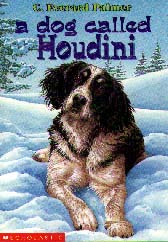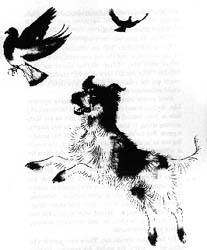|
________________
CM . . . .
Volume VI Number 1 . . . . September 3, 1999


|
A Dog Called Houdini.
C. Everard Palmer.
Markham, ON: Scholastic Canada, 1978 (1999).
97 pp., paper, $4.99.
ISBN 0-590-73465-2.
Subject Heading:
Dogs-Juvenile fiction.
Grades 4 - 7 / Ages 9 - 12.
Review by Joan Simpson.
*** / 4
|

excerpt:
There he was, the marauding dog, trotting along the Canadian Pacific Railway line. His easy gait
and utter lack of concern maddened Amalia.
"Now look at that," he said, stopping the truck. To the dog-catcher, a dog who had committed
this many violations should have been looking over his shoulder. But not this one. He trotted
along like a lord mayor of dogs, especially now that he was ambling along a section of the line
that rode on a trestle bridge, some several meters above the road on which Amalia had stopped.
Getting out of the truck, Amalia picked up the net. He would see what he could do.
 A Dog Called Houdini has been released unchanged but for a new cover which features a
forlorn dog lying in the snow. For the mutt (Houdini), the healthiest and smartest pup of the litter,
life changes dramatically when he is taken to an isolated home north of Lake Superior to be a
guard dog. Nameless and despondent, he capitalizes on a broken leather collar to escape his chain.
He finds a better home with an old backwoods hunter who names him Bubba. But Bubba's
security doesn't last. The hunter dies, and Bubba is alone again. He survives by hunting until
summer campers arrive. Bubba quickly learns that stealing food is easier than hunting. When
winter returns, Bubba moves into town where his notorious escapades become a problem for the
mayor who summons the Dog Control Officer. However, the wise mutt repeatedly eludes capture,
thereby acquiring the name "Houdini" and the reputation of "superdog." To the humiliated
dog-catcher, Houdini becomes an obsession and ironically, to the catcher's son, a friend. Told
sympathetically from Houdini's point of view, the harshness of the dog's life is never
overwhelming due to the effective use of humour. The realistic remote setting, diverse characters
and serious issues of human cruelty and responsibility could stimulate interesting discussions.
A Dog Called Houdini has been released unchanged but for a new cover which features a
forlorn dog lying in the snow. For the mutt (Houdini), the healthiest and smartest pup of the litter,
life changes dramatically when he is taken to an isolated home north of Lake Superior to be a
guard dog. Nameless and despondent, he capitalizes on a broken leather collar to escape his chain.
He finds a better home with an old backwoods hunter who names him Bubba. But Bubba's
security doesn't last. The hunter dies, and Bubba is alone again. He survives by hunting until
summer campers arrive. Bubba quickly learns that stealing food is easier than hunting. When
winter returns, Bubba moves into town where his notorious escapades become a problem for the
mayor who summons the Dog Control Officer. However, the wise mutt repeatedly eludes capture,
thereby acquiring the name "Houdini" and the reputation of "superdog." To the humiliated
dog-catcher, Houdini becomes an obsession and ironically, to the catcher's son, a friend. Told
sympathetically from Houdini's point of view, the harshness of the dog's life is never
overwhelming due to the effective use of humour. The realistic remote setting, diverse characters
and serious issues of human cruelty and responsibility could stimulate interesting discussions.
It
should be noted that in a brief history of the town, the term "Indian" is used rather than the now
more generally accepted word, "Aboriginals," a circumstance which may be of concern to some.
Recommended.
Joan Simpson is a teacher-librarian in Winnipeg, MB.

To comment on this title or this review, send mail to cm@umanitoba.ca.
Copyright © the Manitoba Library Association.
Reproduction for personal use is permitted only if this copyright notice
is maintained. Any other reproduction is prohibited without
permission.
Published by
The Manitoba Library Association
ISSN 1201-9364
TABLE OF CONTENTS FOR THIS ISSUE - September 3,
1999.
AUTHORS |
TITLES |
MEDIA REVIEWS |
PROFILES |
BACK ISSUES |
SEARCH |
CMARCHIVE |
HOME
|

 A Dog Called Houdini has been released unchanged but for a new cover which features a
forlorn dog lying in the snow. For the mutt (Houdini), the healthiest and smartest pup of the litter,
life changes dramatically when he is taken to an isolated home north of Lake Superior to be a
guard dog. Nameless and despondent, he capitalizes on a broken leather collar to escape his chain.
He finds a better home with an old backwoods hunter who names him Bubba. But Bubba's
security doesn't last. The hunter dies, and Bubba is alone again. He survives by hunting until
summer campers arrive. Bubba quickly learns that stealing food is easier than hunting. When
winter returns, Bubba moves into town where his notorious escapades become a problem for the
mayor who summons the Dog Control Officer. However, the wise mutt repeatedly eludes capture,
thereby acquiring the name "Houdini" and the reputation of "superdog." To the humiliated
dog-catcher, Houdini becomes an obsession and ironically, to the catcher's son, a friend. Told
sympathetically from Houdini's point of view, the harshness of the dog's life is never
overwhelming due to the effective use of humour. The realistic remote setting, diverse characters
and serious issues of human cruelty and responsibility could stimulate interesting discussions.
A Dog Called Houdini has been released unchanged but for a new cover which features a
forlorn dog lying in the snow. For the mutt (Houdini), the healthiest and smartest pup of the litter,
life changes dramatically when he is taken to an isolated home north of Lake Superior to be a
guard dog. Nameless and despondent, he capitalizes on a broken leather collar to escape his chain.
He finds a better home with an old backwoods hunter who names him Bubba. But Bubba's
security doesn't last. The hunter dies, and Bubba is alone again. He survives by hunting until
summer campers arrive. Bubba quickly learns that stealing food is easier than hunting. When
winter returns, Bubba moves into town where his notorious escapades become a problem for the
mayor who summons the Dog Control Officer. However, the wise mutt repeatedly eludes capture,
thereby acquiring the name "Houdini" and the reputation of "superdog." To the humiliated
dog-catcher, Houdini becomes an obsession and ironically, to the catcher's son, a friend. Told
sympathetically from Houdini's point of view, the harshness of the dog's life is never
overwhelming due to the effective use of humour. The realistic remote setting, diverse characters
and serious issues of human cruelty and responsibility could stimulate interesting discussions.